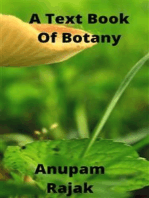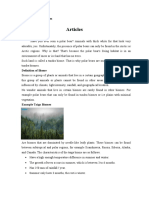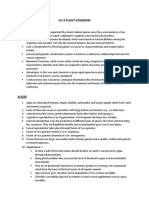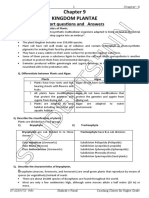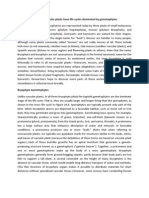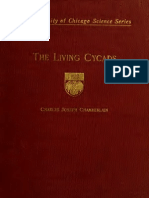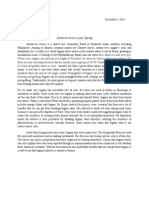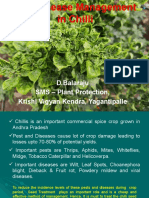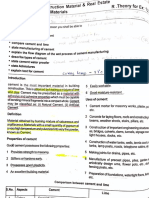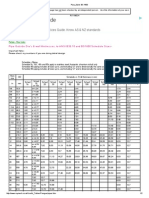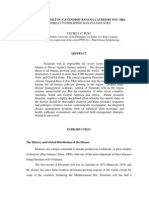Professional Documents
Culture Documents
Saba
Uploaded by
sid_32pariOriginal Description:
Original Title
Copyright
Available Formats
Share this document
Did you find this document useful?
Is this content inappropriate?
Report this DocumentCopyright:
Available Formats
Saba
Uploaded by
sid_32pariCopyright:
Available Formats
Male gametophytes of Polytrichum strictum bearing antheridia.
Scientific classification
Kingdom: Plantae
Division: Bryophyta Class: Polytrichopsida Subclass: Polytrichidae Order: Polytrichales Family: Polytrichaceae Genus: Polytrichum Hedw. Polytrichum is a genus of mosses commonly called haircap moss or hair moss which contains approximately 70 species that cover a cosmopolitan distribution.
The Polythrichum genus has a number of closely related sporophytic characters. The scientific name is derived from the Ancient Greek words polys, meaning "many", and thrix, meaning "hair". This name was used in ancient times to refer to plants with fine, hairlike parts, including mosses, but this application specifically refers to the hairy calyptras found on young sporophytes. There are two major sections of Polytrichum species. The first section Polytrichum has narrow, toothed, and relatively erect leaf margins. The other section Juniperifolia has broad, entire, and sharply inflexed leaf margins that enclose the lamellae on the upper leaf surface
Contents
1 Physiology 2 Classification 3 Species 4 References
Physiology
Mosses in the genus Polytrichum are endohydric, meaning water must be conducted from the base of the plant. While mosses are considered non-vascular plants, those of Polytrichum show clear differentiation of water conducting tissue. One of these water conducting tissues is termed the hadrom, which makes up the central cylinder of stem tissue. It
consists of cells with a relatively wide diameter called hydroids, which conduct water. This tissue is analogous to xylem in higher plants. The other tissue is called leptom, which surrounds the hadrom and contains smaller cells. This tissue is, on the other hand, analogous to phloem Cross section of a leaf of Polytrichum commune showing parallel photosynthetic lamellae at 400x magnification. The green cells contain chloroplasts. Another characteristic feature of the genus is its parallel photosynthetic lamellae on the upper surfaces of the leaves. Most mosses simply have a single plate of cells on the leaf surface, but those of Polytrichum have more highly differentiated photosynthetic tissue. This is an example of a xeromorphic adaption, an
adaptation for dry conditions. Moist air is trapped in between the rows of lamellae, while the larger terminal cells act to contain moisture and protect the photosynthetic cells. This minimises water loss as relatively little tissue is directly exposed to the environment, but allows for enough gas exchange for photosynthesis to take place. The microenvironment between the lamellae can host a number of microscopic organisms such as parasitic fungi and rotifers. Additionally, the leaves will curve and then twist around the stem when conditions become too dry, this being another xeromorphic adaptation. It is speculated that the teeth along the leaf's edge may aid in this process, or perhaps also that they help discourage small invertebrates from attacking the leaves
Classification
The genus Polytrichastrum was separated from Polytrichum in 1971 based on the structure of the peristome which controls spore release However, molecular and morphological data from 2010 support moving some species back into Polytrichum
Species
Polytrichum appalachianum
Polytrichum alpinum Polytrichum commune Polytrichum formosum Polytrichum hyperboreum Polytrichum juniperinum Polytrichum longisetum Polytrichum lyallii Polytrichum ohioense Polytrichum pallidisetum Polytrichum papillatum Polytrichum piliferum Polytrichum sexangulare Polytrichum sphaerothecium Polytrichum strictum Polytrichum swartzii
References
Smith Merrill, Gary L. (2007), "Polytrichum", in Flora of North America Editorial Committee, eds. 1993+, Flora of North America, 27, New York & Oxford: Oxford University Press phylogenetic circumscription of Polytrichastrum (Polytrichaceae): Reassessment of sporophyte morphology supports molecular phylogeny",
Bell, NE; Hyvnen, J (2010), "Phylogeny of the moss class Polytrichopsida (BRYOPHYTA): Generic-level structure and incongruent gene trees"
You might also like
- FernDocument29 pagesFernMazlina NinaNo ratings yet
- Pteridophyta Basic CharacteristicsDocument4 pagesPteridophyta Basic CharacteristicsLata Rajendra VaishNo ratings yet
- The Plant KingdomDocument8 pagesThe Plant KingdomRoxenette Gil Bernales PangilinanNo ratings yet
- Plant Morphology and DiversityDocument10 pagesPlant Morphology and Diversityalyssa mae antonioNo ratings yet
- Division BryophytaDocument8 pagesDivision BryophytaManuelNo ratings yet
- Bio 102 Powerpoint - 112601Document41 pagesBio 102 Powerpoint - 112601faborodeharyomideNo ratings yet
- Hornwort - WikipediaDocument33 pagesHornwort - WikipediaNaniNo ratings yet
- E QUE 08 BotanyDocument6 pagesE QUE 08 BotanyBillQueNo ratings yet
- Lab Report Group 3Document57 pagesLab Report Group 3farid108100% (1)
- Presentation 1Document17 pagesPresentation 1dani ch100% (1)
- Biology Times - February 2019Document68 pagesBiology Times - February 2019Reticent IkNo ratings yet
- PlantsDocument93 pagesPlantsnehmiryll sumaletNo ratings yet
- Lab Leaves Phys FactorsDocument5 pagesLab Leaves Phys FactorsAdelegn BogaleNo ratings yet
- Kingdom PlantaeDocument27 pagesKingdom PlantaeKinza AminNo ratings yet
- AP Biology - Chapter 29 NotesDocument9 pagesAP Biology - Chapter 29 NotesTrinidad AlcalaNo ratings yet
- Gen CHR, Classificatn BryoDocument20 pagesGen CHR, Classificatn BryoadekNo ratings yet
- Course Notes - Bryophyte Training Day For RangersDocument13 pagesCourse Notes - Bryophyte Training Day For RangersMartin HindNo ratings yet
- Questionnaire On BryophytaDocument3 pagesQuestionnaire On Bryophytadarshancool25No ratings yet
- Gametophyte Is The Dominant Generation in The Life Cycles of BryophytesDocument19 pagesGametophyte Is The Dominant Generation in The Life Cycles of BryophytesOthembele GcabaNo ratings yet
- Vascular PlantsDocument24 pagesVascular Plantsgothmoz2No ratings yet
- Plant KingdomDocument9 pagesPlant KingdomsanaullahNo ratings yet
- Moss - WikipediaDocument88 pagesMoss - WikipediaNaniNo ratings yet
- Phylum Bryophyta: Group MembersDocument29 pagesPhylum Bryophyta: Group MembersAkil DhoniNo ratings yet
- W7 NotesDocument21 pagesW7 NotesAmy SuarezNo ratings yet
- Bryo Poster 1Document2 pagesBryo Poster 1Anisa Maharani Putri SuhartoNo ratings yet
- ANSAY, Noahnn Grace R. - Lab 8. Diversity of Nonvascular PlantsDocument13 pagesANSAY, Noahnn Grace R. - Lab 8. Diversity of Nonvascular PlantsESCOSIA, Danica Mae I.No ratings yet
- Diversity in The Plant KingdomDocument14 pagesDiversity in The Plant KingdomJimmy Serendip100% (1)
- Bryophyta Water Relations PDFDocument40 pagesBryophyta Water Relations PDFCDB 1st Semester 2077No ratings yet
- Ecological Adaptations in Hydrophytes and XerophytesDocument9 pagesEcological Adaptations in Hydrophytes and XerophytesDulay, Shennah S.No ratings yet
- Notes On Pteridophytes - 113258Document6 pagesNotes On Pteridophytes - 113258Borisade Tolulope VictorNo ratings yet
- FernDocument16 pagesFernx456456456xNo ratings yet
- Pteridophyte (Introductio, Reproduction Etc.)Document15 pagesPteridophyte (Introductio, Reproduction Etc.)Joy GhoshNo ratings yet
- Fern and Fern Allies (Repaired) 111Document126 pagesFern and Fern Allies (Repaired) 111Fiixaa B OlqabaaNo ratings yet
- Army Public School Gopalpur: Class 11 Science Subject - BiologyDocument6 pagesArmy Public School Gopalpur: Class 11 Science Subject - BiologyAshok KumarNo ratings yet
- V05N03 - 255 Heterosporous PteridophytesDocument6 pagesV05N03 - 255 Heterosporous PteridophytessellaginellaNo ratings yet
- Hari's - PaperDocument34 pagesHari's - PapermuhammadkdrNo ratings yet
- Articles: Nama: Seprianus Missa Nim: 16150120Document7 pagesArticles: Nama: Seprianus Missa Nim: 16150120seprianus missaNo ratings yet
- GrasshoppersDocument8 pagesGrasshoppersleonel ocanaNo ratings yet
- Pteridophyta Classification: 1. Pteridophytes Are Considered As The First Plants To Be Evolved On LandDocument7 pagesPteridophyta Classification: 1. Pteridophytes Are Considered As The First Plants To Be Evolved On LandAashankNo ratings yet
- AP Biology - Chapter 29 Discussion AnswersDocument3 pagesAP Biology - Chapter 29 Discussion Answersangel91me6371100% (1)
- FUNGI AND PROTOZOA - BSEdIIIPDocument57 pagesFUNGI AND PROTOZOA - BSEdIIIPKarl Francis GarciaNo ratings yet
- CBSE Class 11 Biology Chapter 3 Plant Kingdom NotesDocument5 pagesCBSE Class 11 Biology Chapter 3 Plant Kingdom NotesVinod MishraNo ratings yet
- Lecture 8 Notes 2013Document3 pagesLecture 8 Notes 2013Richard HampsonNo ratings yet
- Literature Review On PteridophytesDocument6 pagesLiterature Review On Pteridophytesbij0dizytaj2100% (1)
- CH 3 Plant Kingdom NotesDocument4 pagesCH 3 Plant Kingdom NotesJiya GeorgeNo ratings yet
- Brown AlgaeDocument19 pagesBrown AlgaelaluwimaNo ratings yet
- Chapter 2 - Seedless Vascular PlantsDocument11 pagesChapter 2 - Seedless Vascular PlantsAideruos AhmedNo ratings yet
- Nicole B. Apita Grade IV SincerityDocument3 pagesNicole B. Apita Grade IV SinceritySamantha Nisperos DelacruzNo ratings yet
- Cryptogam DiversityDocument27 pagesCryptogam Diversityshahrafiq.ku21No ratings yet
- Kingdom Plantae: Short Questions and AnswersDocument17 pagesKingdom Plantae: Short Questions and AnswersNadeem ArainNo ratings yet
- Department of Biological Science Plant Biology and Biotechnology Unit PBB 213 - Bryology and PteridologyDocument17 pagesDepartment of Biological Science Plant Biology and Biotechnology Unit PBB 213 - Bryology and PteridologyKhan KhanNo ratings yet
- Botany Assignment - Chapter 20Document9 pagesBotany Assignment - Chapter 20FrancineAntoinetteGonzalesNo ratings yet
- Unit Bryophyta (Paper Code 502)Document47 pagesUnit Bryophyta (Paper Code 502)Abhishek Singh Chandel0% (1)
- Mosses and Other Nonvascular Plants Have Life Cycles Dominated by GametophytesDocument3 pagesMosses and Other Nonvascular Plants Have Life Cycles Dominated by GametophytesShaira RubanteNo ratings yet
- Division Bryophyta PDFDocument29 pagesDivision Bryophyta PDFPee BeeNo ratings yet
- BLY 121 Notes - Students VersionDocument6 pagesBLY 121 Notes - Students VersionLadiNo ratings yet
- Pteridophytes IntroductionDocument4 pagesPteridophytes IntroductionSanchita Kulshrestha100% (1)
- System No. HW-D-0441Document1 pageSystem No. HW-D-0441kirollos HabibNo ratings yet
- AWAAZ LYRICS - Qismat - Ammy Virk - Kamal KhanDocument7 pagesAWAAZ LYRICS - Qismat - Ammy Virk - Kamal KhanAliNo ratings yet
- The Living Cycads Charles Joseph ChamberlainDocument196 pagesThe Living Cycads Charles Joseph Chamberlaina_clossNo ratings yet
- Weekly Report - No#6.... (Sample)Document10 pagesWeekly Report - No#6.... (Sample)Hesham HassanNo ratings yet
- Plant Identification On The Forest Service Road Juan Tomas in The Sandia MountainsDocument39 pagesPlant Identification On The Forest Service Road Juan Tomas in The Sandia MountainsStar LightNo ratings yet
- Estimate North Side NoyyalDocument58 pagesEstimate North Side NoyyalRaj DharmaNo ratings yet
- Grassland Landscape ManagementDocument22 pagesGrassland Landscape Managementk.rajaNo ratings yet
- Broccoli and Cauliflower Production GuideDocument3 pagesBroccoli and Cauliflower Production GuidearnoldalejadoNo ratings yet
- Antidesma BuniusDocument2 pagesAntidesma BuniusJo FernandezNo ratings yet
- Summer Cottage Garden: Plant ListDocument2 pagesSummer Cottage Garden: Plant ListLeandro VitelliNo ratings yet
- Swimming Pool-BoQDocument8 pagesSwimming Pool-BoQSolomon Ahimbisibwe100% (1)
- Module 4 Study GuideDocument4 pagesModule 4 Study GuidekaicaNo ratings yet
- Class, Grade 5 Coral Class and Grade 5 Jade Class) - Population Who Are Involve in The Ornamental Plant PropagationDocument9 pagesClass, Grade 5 Coral Class and Grade 5 Jade Class) - Population Who Are Involve in The Ornamental Plant PropagationJohn Lewis Suguitan100% (3)
- Manual For Quality Seed Production in Wheat.: January 2014Document74 pagesManual For Quality Seed Production in Wheat.: January 2014astuteNo ratings yet
- EPP-Agriculture 6 3 Week 2: Learning Area Grade Level Quarter DateDocument4 pagesEPP-Agriculture 6 3 Week 2: Learning Area Grade Level Quarter DateJari CruzNo ratings yet
- Inplant TrainingDocument19 pagesInplant TrainingKlien ParkerNo ratings yet
- RCC Drain - DIM & RF Details DrawingDocument2 pagesRCC Drain - DIM & RF Details DrawingGOMASH RCP100% (5)
- DSR 2002Document576 pagesDSR 2002HolaNo ratings yet
- Management of Viral Diseases in ChillisDocument16 pagesManagement of Viral Diseases in ChillisBalaraju DesuNo ratings yet
- Envis Dec08 March09Document8 pagesEnvis Dec08 March09Pramba Kumar AhujaNo ratings yet
- Draughtsman Civil Materials: CementDocument4 pagesDraughtsman Civil Materials: CementHARIJITH K SNo ratings yet
- Harga Acp (Alumunium Composit Panel) Merk Ukuran USD Satuan HargaDocument2 pagesHarga Acp (Alumunium Composit Panel) Merk Ukuran USD Satuan HargaSigit Andi PNo ratings yet
- NewbookchapteranthuriumDocument8 pagesNewbookchapteranthuriumTaashi Tiyon RuwanpathiranaNo ratings yet
- BS 1600Document2 pagesBS 1600visio2004No ratings yet
- Topic 3 QuizDocument4 pagesTopic 3 Quizapi-384204029No ratings yet
- Flower For ReadingDocument11 pagesFlower For ReadingCrystal Sim Ming XiaNo ratings yet
- INTRODUCTIONDocument6 pagesINTRODUCTIONArnel SisonNo ratings yet
- MonocotyledonDocument30 pagesMonocotyledonKweh Jian YiNo ratings yet
- 9 Plant Defense MechanismsDocument5 pages9 Plant Defense MechanismsVictor Jose Centeno MartinezNo ratings yet
- Fusarium Wilt in 'Cavendish' Banana Caused by Foc TR4: A Threat To Philippine Banana IndustryDocument17 pagesFusarium Wilt in 'Cavendish' Banana Caused by Foc TR4: A Threat To Philippine Banana IndustryCecirly Gonzales PuigNo ratings yet















